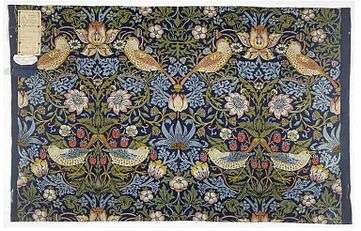Strawberry Thief (William Morris)

Strawberry Thief is one of William Morris's most popular repeating designs for textiles. It takes as its subject the thrushes that Morris found stealing fruit in his kitchen garden of his countryside home, Kelmscott Manor, in Oxfordshire. To print the pattern Morris used the ancient and painstaking indigo-discharge method he admired above all forms of printing. He first attempted to print by this method in 1875 but it was not until 1881, when he moved into his factory at Merton Abbey Mills, near Wimbledon, that he succeeded. In May 1883 Morris wrote to his daughter, "I was a great deal at Merton last week ... anxiously superintending the first printing of the Strawberry thief, which I think we shall manage this time." Pleased with this success, he registered the design with the Patents Office. This pattern was the first design using the technique in which red (in this case alizarin dye;) and yellow (weld) were added to the basic blue and white ground.
The entire process would have taken days to complete and consequently, this was one of Morris & Co.'s most expensive cottons. Customers were not put off by the high price, however, and Strawberry Thief proved to be one of Morris's most commercially successful patterns. This printed cotton furnishing textile was intended to be used for curtains or draped around walls (a form of interior decoration advocated by William Morris), or for loose covers on furniture.
See also
Bibliography
- Jackson, Anna (ed.) (2001). V&A: A Hundred Highlights. V&A Publications. ISBN 1-85177-365-7